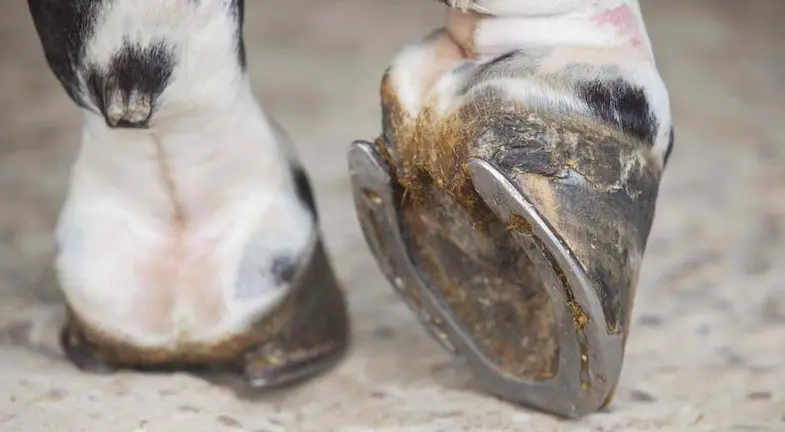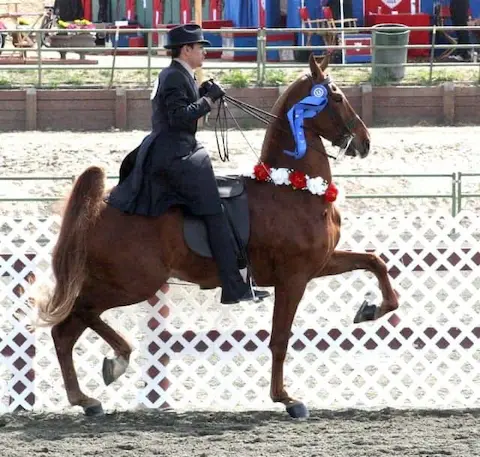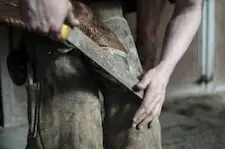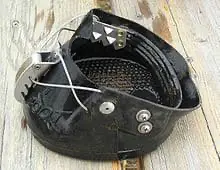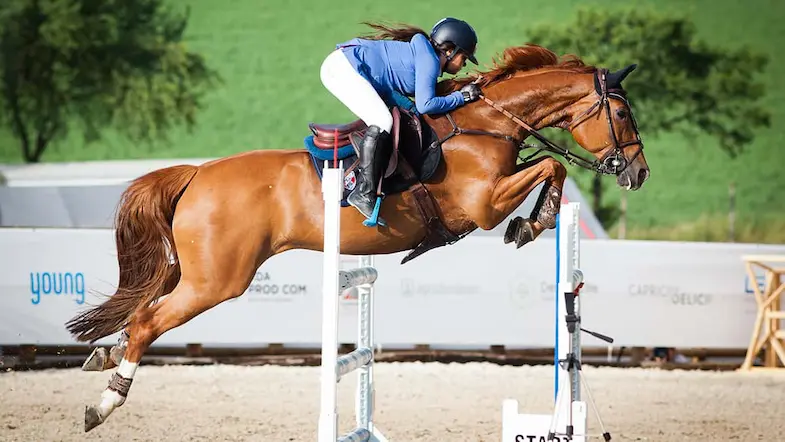The question of whether horses need shoes or not is an age-old one and with everybody having their own opinion on what is right or wrong it can be difficult to know what the best option for your horse is. After all, in the wild horses don’t wear shoes (or even have their feet trimmed), but domesticated horses live in very different conditions to their wild counterparts, and also lead wildly different lives.
I don’t want to tell you what you should or shouldn’t be doing because every horse, and every case, is different, instead, I just want to give you the facts so that you can make an informed decision.
Why don’t wild horses need shoes?
In the wild horses can, and regularly do, cover vast distances (often up to 50 miles (80 km) a day) in search of food which, combined with their native habitat of dry arid climates, means that their feet are trimmed as they walk. This regular trimming also helps to keep them even and, over time, starts to harden and thicken the wall of the hoof which means that they aren’t as prone to injury and damage as domesticated horses.
Why do horses wear shoes?
Every owner will have a different reason for shoeing their horse but in the vast majority of cases it’ll be due to one of the following reasons:
Environmental conditions
Domesticated horses lead very different lives to wild horses and while this has helped to improve their quality of life tremendously it has also sadly had a detrimental effect on the health of their hooves. Instead of continually ‘filing’ their hooves as they move the softer ground often leads to weaker hooves that are more prone to cracking.
Another environmental factor with domesticated horses is that they’re often stabled for long periods of time. While the advantages or disadvantages of this are a separate issue (discussed in more detail here if you’re interested) the wet bedding and ammonia (the rather pungent gas found in urine) work to weaken the keratin in the hoof wall which, over time, will cause them to crack as well as become brittle and soft.
Extra weight
Regardless of whether it’s pulling a plow or carriage or simply carrying a rider, extra weight can put additional stress on a horse’s hoof. That doesn’t mean to say we shouldn’t ride, or should only do so if the horse has been shod, just that, if the ground is soft this will put an added strain on the hooves.
When you consider that the optimum condition for a horse’s hooves is for the ground to be dry (and the terrain to not be smooth) and for the horse to carry no more than their own weight its easy to see that with the extra weight there’s an increased chance of damage.
This is even more evident with horses used for agricultural work, normally when they’re pulling a plow they’re doing so over ground that is soft and often contains a lot of moisture.
For extra grip
If you’re regularly riding over changeable terrain or slippery ground such as mud or snow then shoes can give your horse extra grip. The shoes can also be fitted with studs to give even more grip, or with special pads to stop snow building up in them.
Accentuate gait
In the show ring, many gaited breeds are judged on their naturally graceful movements and high knee action. While this movement is often completely natural, special shoes are regularly used to help exaggerate this movement.
Corrective shoeing
Horses with musculature or bone problems often need special shoes to help to correct the problems that they have. The shape, weight, and thickness of the shoes can all affect the way a horse moves so a farrier will use this to his advantage and fit shoes accordingly.
Racehorses that display any type of weakness in their foot or leg will also wear special shoes to help correct this.
Prevent tripping
There can be a whole plethora of reasons for a horse tripping but in some cases, such as with young and inexperienced horses, special shoes can help to correct this. These shoes will have some sort of ramp or slope at the front that will allow the horse to pick up his feet with minimal effort.
Do horse shoes hurt?
Horses’ hooves are made from a protein called keratin and are similar in structure to our finger (or toe) nails. This means that they don’t have any nerves so can’t feel anything, just the same as we don’t feel anything when we cut our nails.
If a horseshoe is fitted correctly by a trained farrier then they won’t hurt the horse at all, in fact, the horse won’t even know he’s wearing them. That said though, while the wall doesn’t have any nerves other parts of the hoof do and if they’re not fitted properly the shoe (or nails) can cause a great deal of pain, stress, and discomfort to the horse.
How often do horses need new shoes?
Horse’s hooves continuously grow which means that not only do they need to be trimmed regularly, but the shoes also need to be replaced at the same time, even if they’re not particularly worn.
Providing your horse hasn’t thrown a shoe (meaning they’ve lost a shoe or a shoe has fallen off) then they should have their feet trimmed and shoes replaced every four to six weeks.
Are there alternatives to traditional horseshoes?
There will always be some horses who, for one reason or another, simply can’t wear traditional shoes that have been fastened with nails, whether their hoof wall is too thin or they’re prone to being lame or they just don’t like nails. In the past, this was a real problem for horses that really do need to be shod but today there’s a range of different options depending on your preference or what works best for your horse.
Glue
If you find that traditional metal horseshoes work best for your horse but don’t find that the nails do then glue is definitely going to be the best option for you. As the name suggests the shoes are fixed to your horse’s hooves with glue. The process is straightforward, doesn’t require a farrier (although they will still need to trim your horse’s hooves beforehand if necessary) and many will argue is better for the horse because their hooves aren’t held off of the ground for extended periods of time. Shoes that have been glued are just as strong and sturdy as those fixed with nails.
Clip-on shoes
A relatively new product on the horse market, having only been around for the past few years, clip-on horseshoes are ideal if you like the idea of your horse being ‘barefooted’ but need extra grip, traction, or cushioning while working your horse.
As well as being easy to remove after these boots, which are made of plastic, are great at absorbing shocks and minimizing any stress that the legs can suffer during exercise, especially on harder ground. They’re also more flexible than traditional shoes so allow the hoof to do its job too.
Horse boots
Much like clip-on’s, horse boots can easily be removed when they’re not needed and are more flexible than traditional shoes. They should only be used when riding or working the horse and never when turned out which is one of the reasons why they’re so popular. They offer the best of both worlds.
If you want to use these instead of shoes then some horses will find them a little bit uncomfortable at first so it’s important to acclimatize them to the boots. This can easily be done by putting them on your horse for short periods (around 15 to 20 minutes) and then walking him around. After a few weeks, he should be able to wear them properly.
The main drawback to boots though is that some horses just don’t like them and will try to shake them off, this is because although they’re lightweight they do cover the whole hoof and can occasionally be felt against the fetlock.
Do horses need shoes for trail riding?
Your horse doesn’t necessarily need to wear shoes just because you’re trail riding. Yes, the shoes will help to dissipate the extra weight of the rider and tack but the terrain will be more of a deciding factor than just the type of riding you’re doing. If the going is relatively even and firm then shoes won’t be as important. If, however though, you’re riding over loose, and, or soft ground then wearing shoes will help to give your horse extra grip and traction.
Do horses need shoes to ride on roads?
Whether or not your horse wears shoes when riding on the road will largely depend on how much time you’re spending on them. If you’re merely crossing the road or aren’t spending much time on the road then, depending on your horse’s overall hoof health, he doesn’t need to wear shoes.
If, however, you’re spending a lot of time riding on hard road surfaces then it would be better for your horse to have shoes fitted. This will give him a certain amount of grip but more importantly will also help to cushion his hooves a little. Shoes (or shoe alternatives) will help to reduce the impact that would otherwise be felt by the hoof hitting the hard road surface. They do this by acting as a shock absorber and work to dissipate that impact rather than allowing it to travel up your horse’s leg and cause stress to the limb.
Do horses need shoes when jumping?
Regardless of what the ground is like there will always be a certain amount of impact when your horse’s front feet hit the ground which is why shoes are important for jumpers. What ever type of shoe you choose to use it will offer a great deal of protection, not only to your horse’s hooves, but also his legs as any impact will travel from his foot up through his leg causing stress to the joints and the bone.
To shoe or not to shoe?
As I said at the start of the article my objective wasn’t to tell you whether you should or shouldn’t be using shoes on your horse but to merely point out the facts and answer a few questions that I’m often asked. I’m not a farrier and have never had any formal farriery (or medical) training so you should never take my advice over that of your farrier or veterinarian, instead I’ve been a horse owner for many decades and have based my conclusions on that alone.
Conclusion
There’s an old 18th century proverb that says ‘no foot, no horse’ and this is so true regardless of whether or not your horse is wearing shoes. Unless you look after your horse’s hooves you’ll be causing him a lot of stress, pain, and discomfort as well as running to risk of incapacitating him.
Further reading
- Protecting your horse from mosquitoes
- When should you retire a horse?
- Everything you need to know about strangles
- Protecting your horse from sunburn
- Treating ulcers naturally
- Mud fever explained
- What your horse’s teeth are telling you?
- Is my horse healthy?
- How to look after an old horse
- Do horses like being ridden?
I hope you found this article helpful. If you did I’d be grateful if you could share it please as it would really help me.
Recommended products
Over the years I have tried hundreds of different horsey products, from various blankets and halters to different treats. Some I’ve loved, others I’ve hated but I thought I’d share with you my top all-time favorite products, the ones I never leave the yard without. I’ve included links to the products (which are in no particular order) that I really think are great.
- Horse Knots by Reference Ready – If you’re like me and enjoy pocket reference guides then you’ll love this knot tying guide. These handy cards can easily fit in your pocket or attach to the saddle for quick reference. They’re waterproof, durable and are color coded to make them easy to follow.
- Mane ’n Tail Detangler – Even if you never show your horse you’ll need to detangle his tail from time to time (and possibly his mane too) which is always a challenging chore! I’ve found that if I run a little bit of detangler through my horse’s tails every few days it stops them from getting matted up and makes combing them easy, even if they’re coated in mud. I don’t know if I should admit to this or not but it also works wonders on my hair.
- TAKEKIT Pro clippers – Over the years I’ve tried a lot of different clippers and while some were obviously better than others I found these to be by far the best. They are heavier than a lot of other clippers but for me, that’s a good thing, it makes them feel more sturdy and hardwearing. On top of that they have a range of speeds so are just as good for clipping your horse’s back as they are his face. I also like the fact that they come in a handy carry case but that’s not for everybody. The company that makes them is super good and incredibly helpful too, a real bonus these days. The only thing I wasn’t keen on was the fact that it doesn’t come with any oil, but that’s not a major problem as it’s not difficult to buy lubricant.
- Shire’s ball feeder – There are so many boredom buster toys out there but I like to use these every day, regardless of whether or not my horses are bored. I find that it helps to encourage my horses to problem solve by rewarding them with treats (or pieces of fruit) but it also mimics their natural grazing behavior which helps to keep them calm and de-stressed.
- Horse safe mirror – This is a strange one that many people are surprised about but I like to put horse safe mirrors in the trailers as well as in the quarantine stalls. It helps to prevent the feeling of isolation by giving the impression of other horses being around. Being herd animals horses can get extremely stressed when they feel that they’re on their own but with these stick-on mirrors, they believe that at least one other horse is with them.
- Rectal thermometer – I know this isn’t glamourous at all but it’s vital for your horse’s well-being to be able to check their temperature and a rectal thermometer is the easiest way of doing this which is why I’ve added it to the list.
Shopping lists
I’ve also put together a few shopping lists of essential items that I’ve found helpful over the years. I’ve broken the lists down into different categories rather than put everything in one massive list 😉

